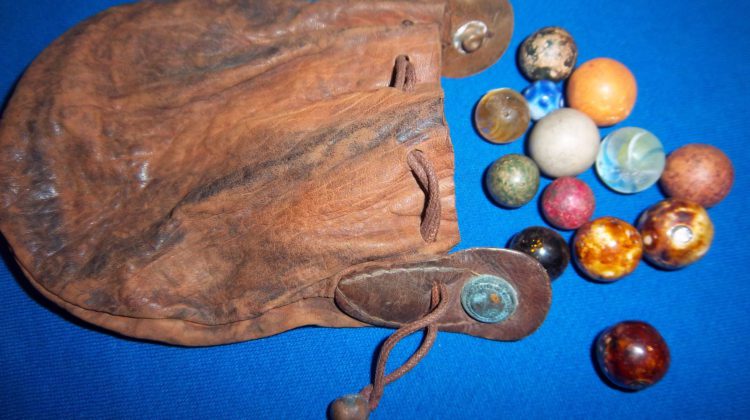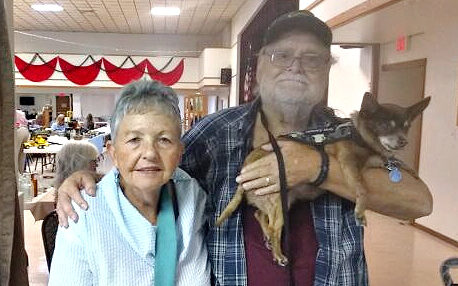
Grab the Marbles & Run!
We really like marble bags! It wasn’t so long ago that young ‘uns for whom marbles was a game of keeps needed a bag, pouch, or their granddad’s old hand-me-down shot pouch to put their winnings in. The bag should be able to hold about 25 – 30 marbles, and there was no real requisite to what it looked like or what it was made of. It could be cow, horse, or donkey hide, a puppy’s tooth cloth bag (yes, we do own one of these), mama’s gingham or flour sack bag, or even an old bank pouch.
From time to time we find these bank bags sold as marble bags, and we were unsure whether or not they were ever used by kids as marble bags. We have a couple of these, and one is from a 1930s long forgotten bank in Missouri. We finally did hear a first-hand report from someone who used one when he was a child who played a lot of marbles. So, yes, bank bags were sometimes used as marble bags. What every marble player needed was something handy to hold his or her winnings in case a quick, unplanned, and precipitous exit from the field of play became paramount.
Shagreen Marble Bags & Galuchat
In 2008 in Tarpon Springs, Florida, at an upscale antique shop, we invested in a very unusual leather marble bag. In the shop we noticed that it has distinct little impressions on it. After some research we learned that this type treatment is generally called shagreen. While shagreen leather was often dyed green, ours is a natural color. Historically, shagreen was made from camel and it was popular in Persia. It has also been made from the hide of the onager (wild ass), donkey, and horse. The hide was taken from the rump just above the tail[1]. Shagreen leather has distinct “goosefeet” impressions all over the outside.
Goosefeet is a weed and one of several perennial or annual plants. You can eat the leaves raw, or cook them like spinach; some people also eat the seed. Sometimes mustard seeds were used to make Shagreen. Either way, the seeds were impressed into the moist hide and it was then left in the sun to dry. In addition to the characteristic impressions, oils from the seed helped the leather tan.
Some marble collectors claim that shagreen leather must be harvested from stingray or shark. Jonathan Wolford’s Blog explains that in 18th century France the leather artist Jean-Claude Galuchat introduced his clients to stingray skin, which has a natural pebbled surface. Stingray has been used in Japan since at least the 8th century, but stingray or sharkskin is now called Galuchat in honor of the leather artist.
An Expensive Bag When New
So, our little bag is shagreen and it holds the requisite twenty-five marbles and a shooter. It has a silk string tie. While we cannot agree on what type hide is used, after some eighty years it is still supple. It is about 5” tall by 3.5” wide. The bag has copper grummets through which the cord passes in order to close the bag. Some of these grummets have pulled loose. The bag also has a stained wooden bead slide, which closes the bag, and two stained bead “fobs”. The bag dates to the 1930s. Whoever owned the bag was determined that it stays closed: it also has one large snap.
We do think that it is too “fancy” to have been a child’s bag. This is a finely made bag, and was doubtless expensive when new. We believe, therefore, that it was bought and used by an adult. Larry’s brother-in-law, Jim Howell, who was in his 70s when we bought the bag, recalled when adults traveled on championship marble tours, and each carried their own personal bags. This may well be how our little bag was used.
Of course, many marble companies made gift boxes which included a bag. There are the well-known Akro Agate Company Popeye gift and No. 250 boxes. We have a No. 250 with all the marbles and a green canvas bag. We also have a large cloth Marble King bag and we know that Christensen made gift sets. We have never seen one, but Peltier Glass Company made a round-bottom draw string bag called “Lucky Boy.” And you were indeed lucky if you received one of these gift sets!
Marble Bags: A Collectors Niche
We have barely scratched the surface of marble pouch collecting. In addition to marbles, collecting old marble pouches is a rich field for anyone intrigued by history, who loves to travel and meet lots of interesting people. For example, there are all sorts of antique branded advertising bags: some are cloth and some are leather. We enjoy these old bags and we get a kick out of learning all about the advertisers. Many, but not all, are long gone from the scene.
A Tourist Bag
Another type bag which fascinates us may be called a tourist bag. These little bags were hand made in the 1930s – 1950s by indigenous peoples who sold the bags to travelers. For example, across Florida in the late 1940s – 1950s Native Americans made all sorts of arts and crafts in their homes near major highways like US 1, 41, 98, 301; and A1A. They essentially sold out of their homes. They made marble bags, and many of these can still be found today. At that time there were no foreign souvenirs to be found.
We have found these tourist bags in and Georgia and Tennessee. In 2018 while on a trip to Tennessee we bought such a brown leather or suede tourist bag with a rounded bottom. It has a seed bead design sewn onto the front which, in the shop, we thought was a thunderbird. However, the beaded figure faces right while most thunderbirds face left. The figure may be Kokopeli or the prankster from Native folklore. The bag is 5¼” tall (5½” counting the short fringe); 4” wide, and it has what looks like a newer twisted fiber drawstring. There are bells on each end of the drawstrings.
Our Favorite Souvenir Bag
One of our favorite souvenir bags is from the “Little Bighorn Battlefield” in Montana. We bought it at one of our favorite antique shops in Wildwood, Florida, in 2016. We learned from research that the park is now “Little Bighorn National Monument”. The bag may date to the 1950s, and it may have originally been bought in a shop near the Battlefield or possibly as far away as Cheyenne, Wyoming, which also caters to tourist traffic bound for the Battlefield.
We really like the pouch because we have remarkably few marbles or marble-related artifacts from West of the Mississippi. It also gave us a chance to review what we know about the Little Bighorn and its history. The pouch is professionally made and is 5¾” deep X 4⅝” wide. It has a rounded bottom and a thick gold-colored cotton cord or draw string. The cording is simply tied in knots on the end and is frayed. There is some staining on the back.

Marble Bags Research
Marble bags and pouches are fun to collect and research. Yes, some can be expensive, but nice old bags can be had for just a few dollars if you are willing to look in such interesting places as antiques fairs, some estate sales, and if you check out “gypsy” vendors who only show up once in awhile at the outskirts of flea markets. It is just amazing the people you will meet along the way and what you can learn. But we will close this Blog with a very odd bag.
A Very Odd Marble Bag
In a very nice antiques shop in Palmetto, Florida, in 2019 we bought a very unusual old marble bag with Chinese Checkers marbles inside.[1] The Checkers bag is leather colored blue. It has “Marbles” across the front and a dog with floppy ears sitting in a ring with marbles. The bag has heavy stitching all around the bottom and sides, and it is 4¾” tall X 3½” X about 2”.
The most singular thing about the bag is its closure. There is a secure metal frame across the top and a snap closure! We have never seen another one like it. Joanne, who is a marble bag-diva, would never have accepted it as a marble bag without the notation “Marbles”! There was an apparently old piece of paper in the bag with the handwritten note: “Mak’s marble bag & Marbles to Chinese Checkers game (1930s).”
How Many Marbles in Chinese Checkers?
There are supposed to be 60 marbles in Chinese Checkers. Our old bag contains 61 marbles. The marbles are almost certainly Akro Agate if the date on the note is correct. While we do not think that the bag was made by Akro, we have no clue who did manufacture it. The old leather is getting somewhat distressed as are some seams.
Some collectors are lucky enough to buy marbles in old bags. They often treasure the marbles but do not value the bags. If you have bags in your marble collection congratulations! If not, now is an excellent time to start searching. Like the marbles themselves, you just never know where the search for old bags will lead you!
Want to know more about marbles?
[1] Check out “Jonathan Walford’s Blog” at https://kickshawproductions.com/blog/ 8/30/2021
[2] Incidentally, Chinese Checkers, Stern-Halma, or “Hop Ching Checkers” did not originate in China and the game has nothing in the world to do with checkers!

